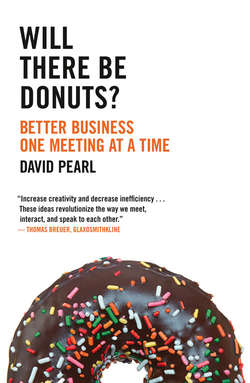Читать книгу Will there be Donuts?: Start a business revolution one meeting at a time - David Pearl - Страница 31
Counting the cost
ОглавлениеWhoa. Did you just give me “the look”? It’s the imperceptible tightening of the brows and lips which says, “I am a hard-nosed business person and what does this soft issue have to do with my bottom line, sonny?”
I’ve seen it the length and breadth of the business world, from boardroom to shop floor. And when I see it I ask clients—as I ask you now—to consider the following:
Imagine you are in a role which requires you to attend three hours of meetings a day. And let’s say you’d score those meetings 70 percent effective. Let’s also imagine there are 100 people like you in the company and that your average wage is, say, $100k. None of this is particularly far-fetched, you’d agree? OK, then.
You just wasted 82 days in meetings this year, costing your company a pretty significant $2m. What’s more, if you were to continue at this rate for a conventional career, you’d be burning a total of nine years, six months, and three days of your working life.
This is hypothetical, but far from fantastical. Here’s a real example which I put in front of the board of a major pharmaceutical company who weren’t immediately convinced that ineffective meetings were having a significant effect on their business.
They’d called me in—as clients often do—to get more creativity into their working practices. People often feel this is a kind of spray-on process but quickly discover that the blocks to creativity lie in some very fundamental practicalities.
In the Pharma’s case the numbers were more like 4.5 hours spent in meetings per day, 60 percent effectiveness, average fully loaded costs of $125,000 and 2500 employees. Put them through the formula and there’s an eye-watering 72 million dollars of invaluable time and cost you just poured down the drain.
By any standards that’s a major mistake to be making. And to keep on making.
So yes, it’s a soft issue. But with a rock hard center. It’s like flying through a cloud with a nasty, big mountain hidden inside it. The implications for your financial as well as physical wellbeing can be sudden and drastic.
When I am talking to people who like to differentiate their activities in terms of “hard stuff” and “soft stuff,” I like to describe the work I do particularly with meetings as “the hard-soft stuff.” Soft, in that it’s broadly a people issue. And hard because it’s tough to fix.
When you start to really change meetings, you are tinkering with the culture of the business, and issues don’t come much trickier. It’s easy enough for your business to commit to culture change when you are on a blue-sky-thinking executive-retreat somewhere nice and warm. But visit the workplace a week or two later and you’ll find the “nearly meeting” culture is as stuck as ever. We’ll look at how to change things more effectively a little later in the book.
Nearly Meetings are a worldwide epidemic. And epidemics are something that one of my clients Thomas Breuer knows more than most about. Thomas doesn’t have a golf trophy in his office. Nor one of those toe-curling posters shot against a Hawaiian sunset saying what a real leader is made of.
Thomas Breuer, a physician and epidemiologist by training, is Head of Global Vaccine Development (GVD) at GlaxoSmithKline Vaccines. In the GVD offices there are photographs of African women and their children. They are there to remind all of them of their deadline to license a malaria vaccine and the devastating prospect on mortality in Africa if they fall behind their target. And malaria is just one area of attention. When H1N1 swine flu last threatened the world, it was on Thomas’s watch. It explains why Thomas is intolerant of outdated processes and wasting time.
When Thomas took over his new role, his first act was to have multiple small informal lunches with groups across his entire staff of 1400 people.
What they told me again and again is that we are wasting huge time and money in meetings. The amount of money we were burning in people time in wasteful meetings was mind-blowing. I realized instead of hiring in or outsourcing there was one untapped jewel sitting in the middle of my department and that by doing meetings better I could create more time for people already in the company and who have the skills I need now.
So, how to engage a group of medics and scientists in meetings when they’d all rather be out saving the world from rotavirus, shingles, cancer, and worse? The answer, it turned out, was to stop focusing on meeting efficiency and start thinking about meeting health. We set up a “meeting hospital” and for three months we took in meetings that were sick, needy, and near death and brought them back to life. Quite a few of the techniques in this book were developed in the emergency ward of the meeting hospital.
The results read like one of those “before and after” weight-loss advertisements. After three months 97 percent of participants found meetings more purposeful, clear, and engaging.
Clearly, with the right antidote and a big bucket of innovation we can tackle nearly meetings. But the question is, if they are so manifestly unhealthy, why do we keep having them?
